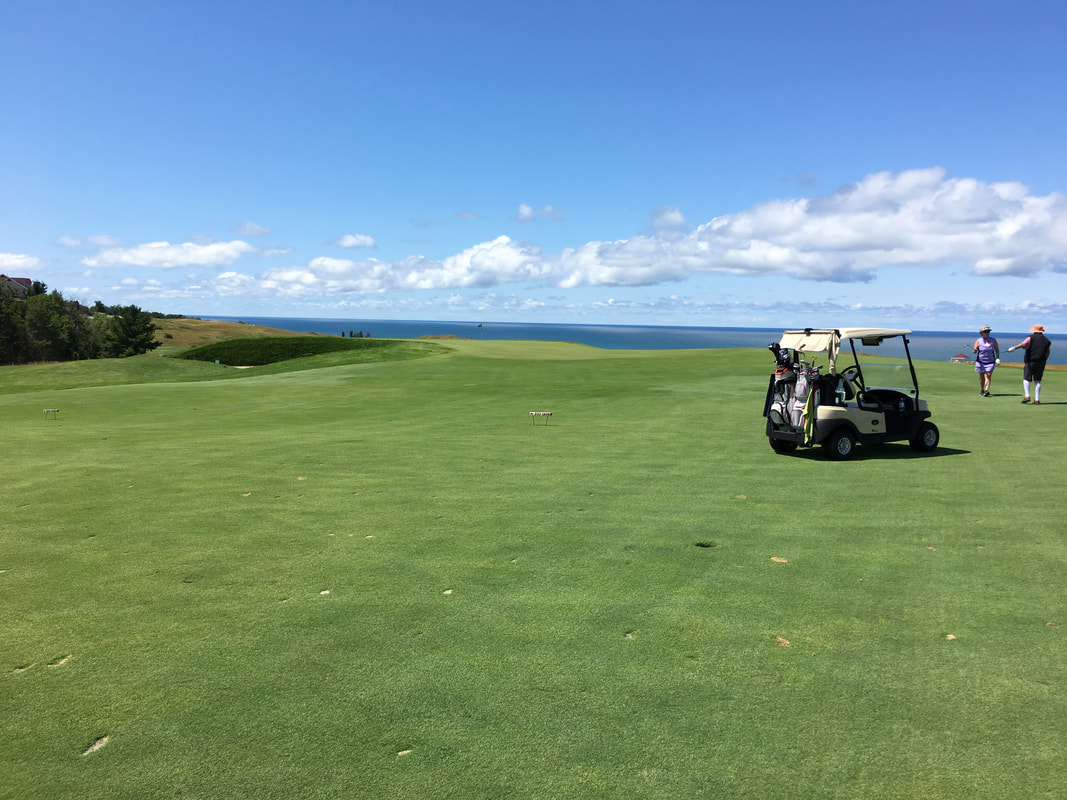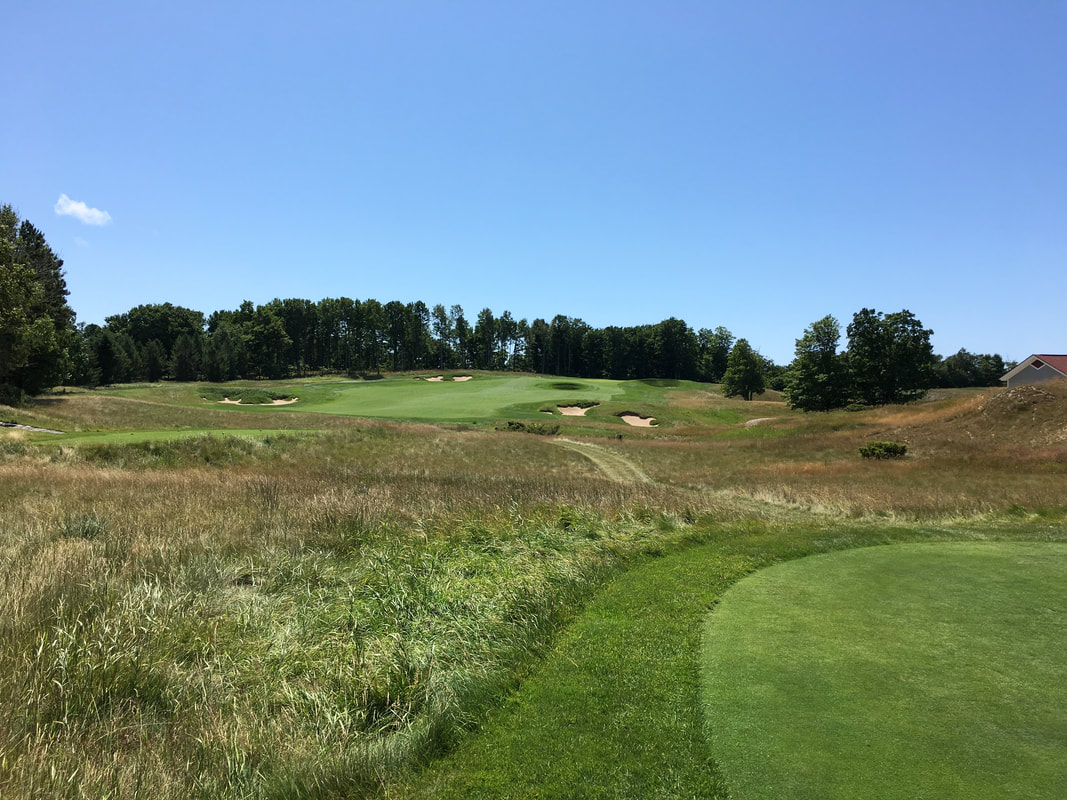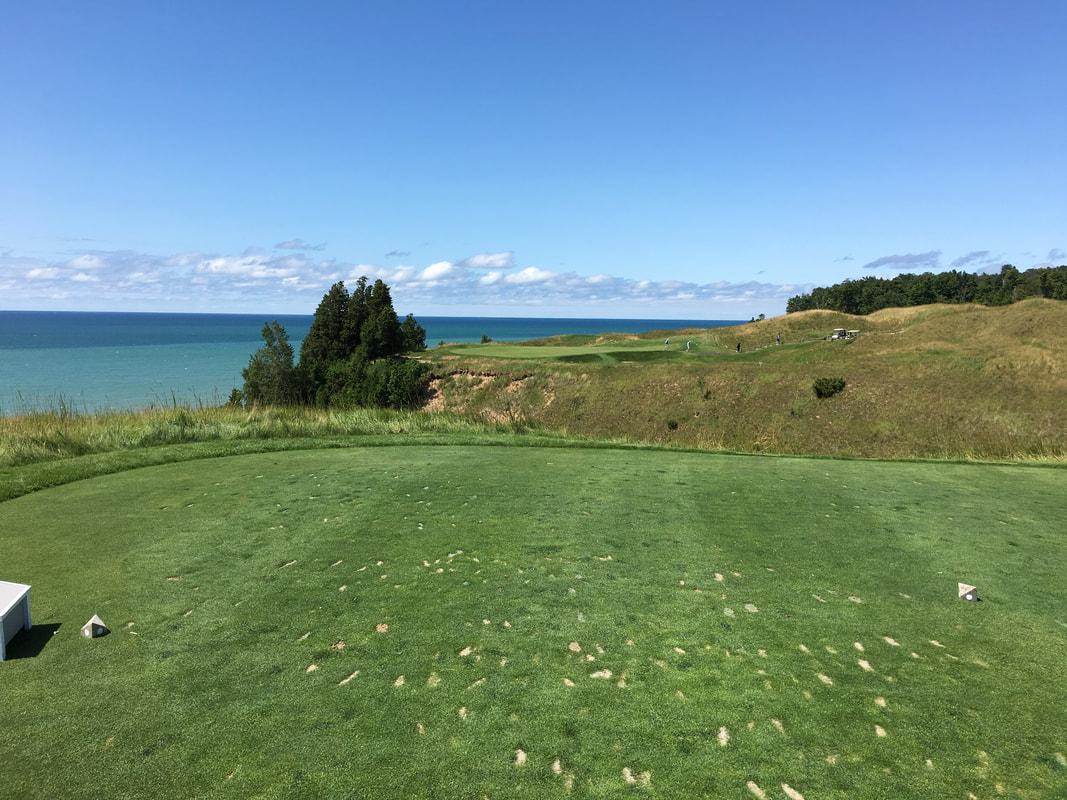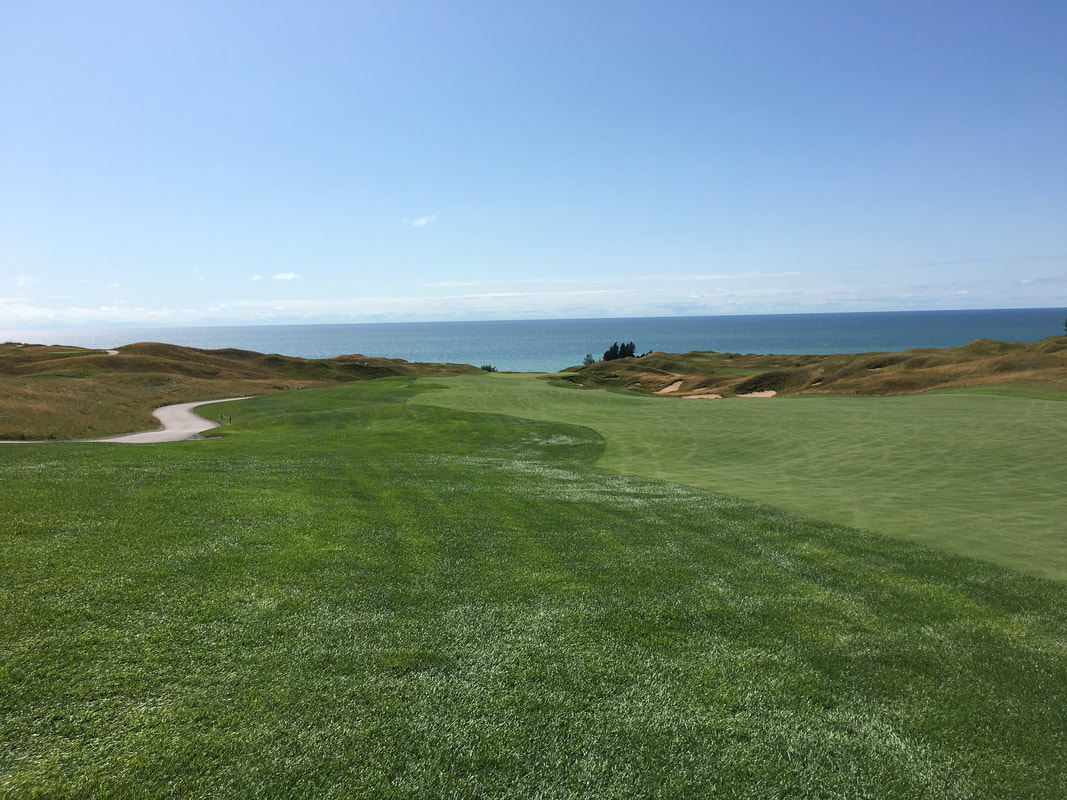When it comes to the original course at Arcadia Bluffs, most regular golfers seem to agree that it’s the best public course in Michigan. It’s beautiful, it’s next to Lake Michigan, the holes are dramatic…there’s a lot to like for the regular golfer (if not for their scores).
But the one group that seems to mostly disagree with this is the golf course architecture nerds. Tom Doak gave it a 6/10 in the most recent edition of the Confidential Guide and his was the highest score of the three who had seen it. This group accuses it of having a disjointed routing and being unwalkable, over-shaped, and too difficult in windy weather (which is, of course common here). And I’d agree with some of all of these criticisms. It’s not readily walkable and it’s not clear why, given that they were willing to move so much earth, that it couldn’t be (well, other than that northern Michigan vacation golfers don’t walk). And it’s over-shaped in places, although I recognize that the ravine-studded site probably required a lot of shaping to be useable at all.
So given all of this and being a golf architecture nerd, why do I agree with the non-nerds that Arcadia Bluffs is the best public course in the state? Because it has several of the best holes in the state and with the exception of the holes on the southwest quarter of the property, the shaping, including on the heaving greens, is very good. And despite several drawbacks, that’s enough to make it for me, if only by a little bit over Forest Dunes and Greywalls, the best public course in this state (in Wisconsin, it wouldn’t be top 3).
The first hole—in fact the first few holes exemplify what I’m talking about when I say that the shaping on many of the holes is very good. Except for the bunkers dotting the rough, it doesn’t look like the first hole had much shaping at all. It’s the first of five excellent par 5s—to me, easily the best set of par 5s on the state’s public courses.
But the one group that seems to mostly disagree with this is the golf course architecture nerds. Tom Doak gave it a 6/10 in the most recent edition of the Confidential Guide and his was the highest score of the three who had seen it. This group accuses it of having a disjointed routing and being unwalkable, over-shaped, and too difficult in windy weather (which is, of course common here). And I’d agree with some of all of these criticisms. It’s not readily walkable and it’s not clear why, given that they were willing to move so much earth, that it couldn’t be (well, other than that northern Michigan vacation golfers don’t walk). And it’s over-shaped in places, although I recognize that the ravine-studded site probably required a lot of shaping to be useable at all.
So given all of this and being a golf architecture nerd, why do I agree with the non-nerds that Arcadia Bluffs is the best public course in the state? Because it has several of the best holes in the state and with the exception of the holes on the southwest quarter of the property, the shaping, including on the heaving greens, is very good. And despite several drawbacks, that’s enough to make it for me, if only by a little bit over Forest Dunes and Greywalls, the best public course in this state (in Wisconsin, it wouldn’t be top 3).
The first hole—in fact the first few holes exemplify what I’m talking about when I say that the shaping on many of the holes is very good. Except for the bunkers dotting the rough, it doesn’t look like the first hole had much shaping at all. It’s the first of five excellent par 5s—to me, easily the best set of par 5s on the state’s public courses.
The second hole is a medium length par 3 with a huge sugar maple to the left and a big bunker to the right. The green is typical for the course; very large and sloping pretty good from back to front. Note the juniper bushes scattered randomly in the long grass left and right—one of my favorite aesthetic details on these more subdued opening holes.
The downhill par 5 third is gorgeous and easily on the short list of best par 5s in the state. We can see all the way to the green (and obviously beyond) from here and this view suggests how we should play the hole. There’s a deep pot bunker in front of the green but fairway short and right—if we can clear two fairway bunkers in the middle of the lay-up zone. And this is exactly how you want to play the hole; the fairway area over these centerline second shot bunkers is larger than it looks and leaves a straight forward shot to another large, rolling green.
The medium length par 4 fourth continues our downhill trek to the lakeside, doglegging right to a punchbowl green. This hole shouldn’t be too much trouble if you don’t spray it too far offline. The fifth is another excellent par 5. The tee shot is wide open and the further you go, the more difficult the decision becomes. A good player will be able to go for the green off a good drive, but it’s all carry over several acres of sand and garbage to a green which is huge, but doesn’t have any room to run the ball up. If you don’t go for it, the lay-up to the right is awkward looking but again, there’s more room than there appears to be.
After an uphill par 3 to a severe three-tiered green, we come to the lovely long par 4 seventh. Whenever someone tells me that Arcadia Bluffs is over-shaped, I think of the seventh, which appears to have no shaping (and no bunkers around the fairway, which flows gradually uphill into the green). There’s ample room to run the ball on the green, although it’d be nice if they maintained more short grass on the slope short left to enable the shorter hitter to use this to feed the ball onto the green.
The medium length par 4 runs uphill and doglegs right. While the right side is a riskier drive, it doesn’t create the best angle of approach, which is actually from the left center. The further you drive your ball up the left, the better view you will have down the open angle of the green. After what seemed like an unnecessarily long drive, we come to the downhill par 3 ninth, this time with the big maple tree on the right side of the green. Don’t miss short or your ball will come 20 yards back down the false front.
The next two holes are probably the two most controversial on the course. Many love them, others think that they’re over-shaped. I’m somewhere in the middle. The tenth is, with the short par 4 fourteenth, my least favorite hole on the course. There’s more room than there looks to be over the mound on the right, but it’s still fairly narrow. I have two main problems with this hole. One, I wish that the shaping of the fairway were consistent with that of the surroundings. I don’t mind the extreme shaping in the rough, but it looks fake when you get to the fairway and the contours suddenly become gentle. The surroundings look like some of the big dune links courses in the UK and Ireland, but there, the fairways have the same heaving contours (which, to be fair, creates lots of blindness—not great for a resort course). Two, the green is too severe. The 20 foot deep pot bunker in the front is ridiculous and honestly, quite dangerous. I got a bit nervous there last time I played when my dad had to play a shot about one foot off the top lip.
The long downhill par 5 eleventh takes us back to Lake Michigan from one of the highest points on the back nine (which we drove 200 yards back uphill to reach). This hole features in a lot of the course’s promotional material and is spectacular. I like it much more than the tenth for a few reasons. One, there’s more strategy off the tee. If you hug the hill on the left course, you can get far enough down to bring the green into range. But the right half of the landing area slopes away to the right, so the weakness of a weak drive is magnified. The lay-up is through a narrow gap between huge fake dunes and bunkers, but it’s easy to get the ball pretty far down just by running it along the ground. The green is saddled shaped, but with a high left tier on top of the saddle on the left. You can easily run the ball into the middle, but this will leave a difficult putt if the pin is on one of the side wings. Altogether, it’s an outstanding hole.
So is the twelfth, a long par four running north along Lake Michigan. The tee shot is maybe the course’s best—over a huge bunker, rewarding those who make the longer carry to the left. The approach to the green is stunning; downhill to a green with two pot bunkers left perched on the edge of the cliff with the lake as entire backdrop, save for a cluster of arborvitae next to the thirteenth green. While there’s room and short grass to run the ball in using the slope on the right side, I think that there could be a bit more fairway on the left. They seem to have intentionally kept the fairway away from the cliff edge, for which there might be good practical reasons (safety, chemical runoff, who knows).
The par 3 thirteenth continues the spectacular golf with a long shot over a huge ravine. It’s a very difficult shot, but the green is large and receptive. A cliffside par 3 is almost a requirement on a course like this and this hole is an appropriate high point after the crescendo of the last few holes (admittedly starting at about ff and going up to ffff).
As mentioned above, the fourteenth is one of my two least favorite holes. Like ten, it’s narrow and surrounded by steep, fake dunes but again, none of these comes into the fairway. The second is also severe, with a green that’s perched on a small hill over a pot bunker and is too shallow for all but very well-struck shots.
The last four holes however are very good. The short par 5 fifteenth runs uphill and has a bunker about 50 yards short of the green, right on the line that you’ll want to run it to try and get a long second onto the green. The long sixteenth is probably the best par 4 on the course. It doglegs gently left with a reverse camber fairway. There’s plenty of room on the right, but you’ll want to keep it up the left for the best angle and the shortest shot. The approach shot is one of the course’s best, with a wide, slightly left-to-right sloping fairway with bunkers and long grass on the right. The fairway short of the green is perfect for running the ball onto the green, even if your tee shot is down the right side.
The last four holes however are very good. The short par 5 fifteenth runs uphill and has a bunker about 50 yards short of the green, right on the line that you’ll want to run it to try and get a long second onto the green. The long sixteenth is probably the best par 4 on the course. It doglegs gently left with a reverse camber fairway. There’s plenty of room on the right, but you’ll want to keep it up the left for the best angle and the shortest shot. The approach shot is one of the course’s best, with a wide, slightly left-to-right sloping fairway with bunkers and long grass on the right. The fairway short of the green is perfect for running the ball onto the green, even if your tee shot is down the right side.
Although it isn't on the lake like the thirteenth, the seventeenth is very dramatic. The surrounding fake dunes aside, it looks like something from a Raynor or a Langford course, with the green built up on a huge shelf about 20 feet above its surroundings on the right. There’s ample room on the green, but I found the shot from down the hill on the right to be very playable too.
Although I my phone ran out of battery power and I don’t have pictures, the finishing hole is a good one. You have to carry or skirt a small centerline bunker, but this shouldn’t be an issue if you hit a decent tee ball. But the most notable thing about the hole is the approach, which is the most steeply uphill on the course. There’s more room to run it up the left and you may not actually make it all the way up the hill to the clubhouse if you miss it short right. The green is also one of the most undulating on the course, ensuring many three putts in front of the spectators on the veranda.
I’ve played Arcadia Bluffs several times over the last 20 years and every time I’m away from the course for a few years, I think that I’m finally going to agree with most of the architecture nerds that it’s overrated. But as of my most recent visit in the summer of 2019, my views on the course haven’t changed much at all (like the underrated Pilgrim’s Run). Arcadia Bluffs has its weaknesses, but it has so many and such strong strengths that it’s easy to side with the golf magazines over the nerds on this one—it’s easily a top 50 public course in the country and maybe even one of the top 100 overall (as Golf Digest has it).
But its weaknesses mean that it’s not head-and-shoulders above its closest competitors, Forest Dunes and Greywalls. Forest Dunes is an especially tough case as it doesn’t have Arcadia’s weaknesses…but it also doesn’t have its highs. To me, Arcadia and Greywalls share more in common: several spectacular and great holes, but trying a bit too hard too often. At Arcadia, the Xs come from wayward shots. At Greywalls, they come from going back-and-forth across the greens. Although I’ve walked Greywalls (not Arcadia), I don’t think that it’s any more walkable than Arcadia. Neither is reasonably walkable unless you’re a hiker. And if you can get one of your playing partners in a cart to shuttle you some of the long distances between the holes, the holes themselves might be more walkable than those at Greywalls. And there are probably fewer opportunities for a broken ankle.
I’ve played Arcadia Bluffs several times over the last 20 years and every time I’m away from the course for a few years, I think that I’m finally going to agree with most of the architecture nerds that it’s overrated. But as of my most recent visit in the summer of 2019, my views on the course haven’t changed much at all (like the underrated Pilgrim’s Run). Arcadia Bluffs has its weaknesses, but it has so many and such strong strengths that it’s easy to side with the golf magazines over the nerds on this one—it’s easily a top 50 public course in the country and maybe even one of the top 100 overall (as Golf Digest has it).
But its weaknesses mean that it’s not head-and-shoulders above its closest competitors, Forest Dunes and Greywalls. Forest Dunes is an especially tough case as it doesn’t have Arcadia’s weaknesses…but it also doesn’t have its highs. To me, Arcadia and Greywalls share more in common: several spectacular and great holes, but trying a bit too hard too often. At Arcadia, the Xs come from wayward shots. At Greywalls, they come from going back-and-forth across the greens. Although I’ve walked Greywalls (not Arcadia), I don’t think that it’s any more walkable than Arcadia. Neither is reasonably walkable unless you’re a hiker. And if you can get one of your playing partners in a cart to shuttle you some of the long distances between the holes, the holes themselves might be more walkable than those at Greywalls. And there are probably fewer opportunities for a broken ankle.
























 RSS Feed
RSS Feed